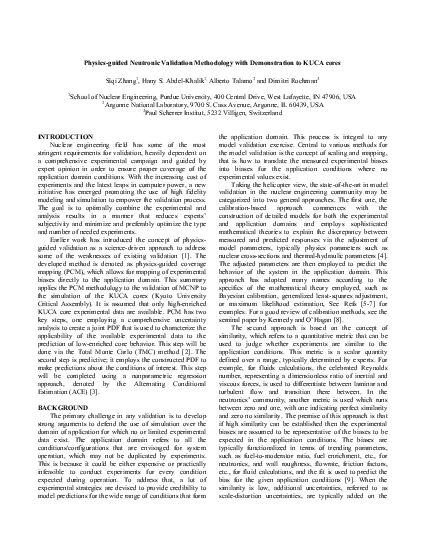

wise energy nuclear data It employs perturbations to the pointwise nuclear data given in the ACE format using the multigroup nuclear data covariance The specific ACE format can be directly transfer ID: 856806
Download Pdf The PPT/PDF document "are functions of p predictors variables" is the property of its rightful owner. Permission is granted to download and print the materials on this web site for personal, non-commercial use only, and to display it on your personal computer provided you do not modify the materials and that you retain all copyright notices contained in the materials. By downloading content from our website, you accept the terms of this agreement.
1 are functions of p predictors variables
are functions of p predictors variables wise energy nuclear data. It employs perturbations to the point-wise nuclear data given in the ACE format using the multi-group nuclear data covariance. The specific ACE format can be directly transferred to MCNP for criticality safety and burnup calculations. The sampling of nuclear data in NUSS method follows the methodology by
2 Wieselquist [16]. Group-wise perturbati
Wieselquist [16]. Group-wise perturbation factors as the ratio between the sampled and nominal group-wise nuclear data are employed to the point-wise nuclear data in the ACE format. The NUSS module to modify the original ACE format separates the entire length of the nuclear data into G groups, which is the number of the energy groups in the given covariance library. The
3 covariance files of ENDF/B-VII.1 are pr
covariance files of ENDF/B-VII.1 are processed in 187 groups and used to generate the random cross section groups. to describe the group-wise flux at certain position with the experimental group-wise flux data from other positions. Figure 7 shows the reconstructed error by the ACE transformation. The x-axis describes the absolute value of the fluxes, and the y-axis re
4 presents the log-10 of the error in rela
presents the log-10 of the error in relative units. Both plots show that the relative errors are uniform regardless of the nominal value of the flux. (a)!Test 1 (b)!Test 2 Figure 7. Reconstructed error by ACE of the application responses CONCLUSION This summary explores the application of a recently-developed physics-guided approach denoted by PCM to support the
5 validation of using MCNP for the analysi
validation of using MCNP for the analysis of the KUCA cores. We investigate the relation of the biases and uncertainties between the highly-enriched fuel pins and low-enriched fuel pins and attempt to find the mapping that describe their mathematical transformation. The numerical results notice a fairly linear correlation for the reactivity, thermal flux and fast flux be
6 tween HEU and LEU. Also, the ACE tests a
tween HEU and LEU. Also, the ACE tests are performed to find the maximum linear effect between the HEU and LEU. For the further work, we want to proceed more detailed discussion about the non-parametric statistical analysis to describe the application response more accurately. REFERENCES 1. H.S. Abdel-Khalik, A. I. Hawari, and C. Wang. "Physics-guided Covered Mapping
7 : a new approach for quantifying experim
: a new approach for quantifying experimental coverage and bias scaling." Transcations of the American Nuclear Society112 (2015): 704-707. 2. D. Rochman, A. Vasiliev, H. Ferroukhi, T. Zhu, S. C. van der Marck, and A. J. Koning. "Nuclear data uncertainty for criticality-safety: Monte Carlo vs. linear perturbation." Journal of Data Science 2, no. 4 (2004): 329-346. 15. T